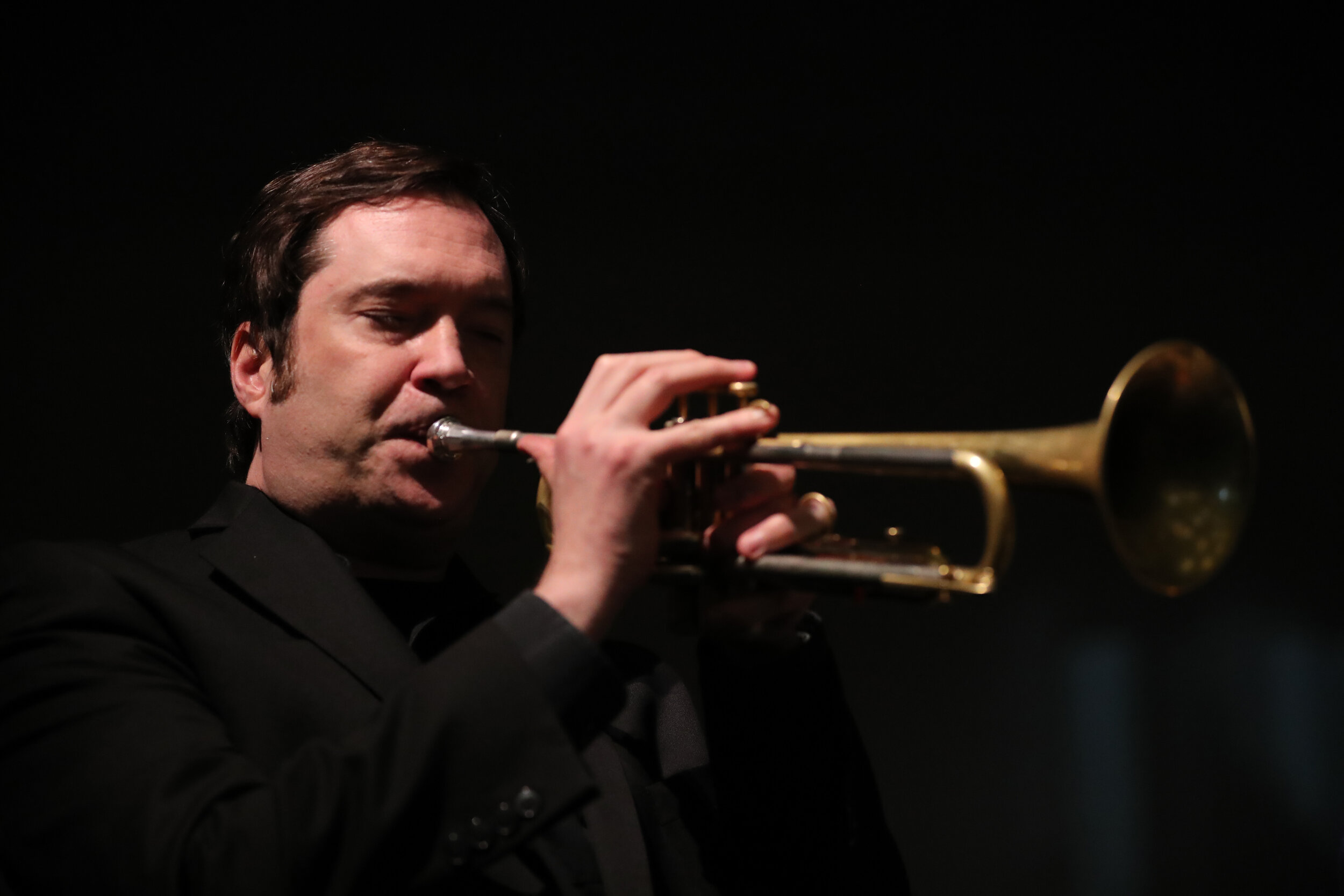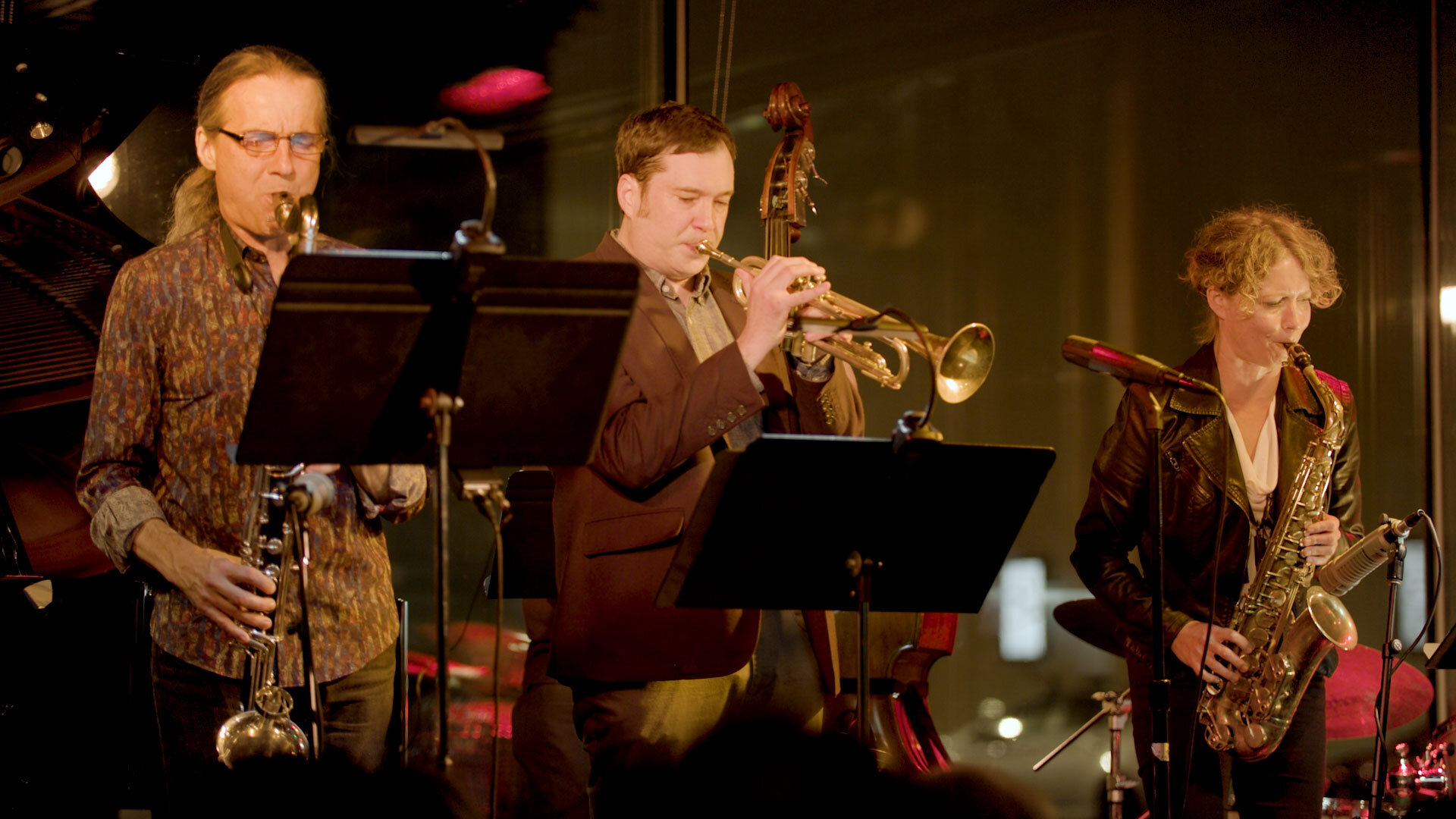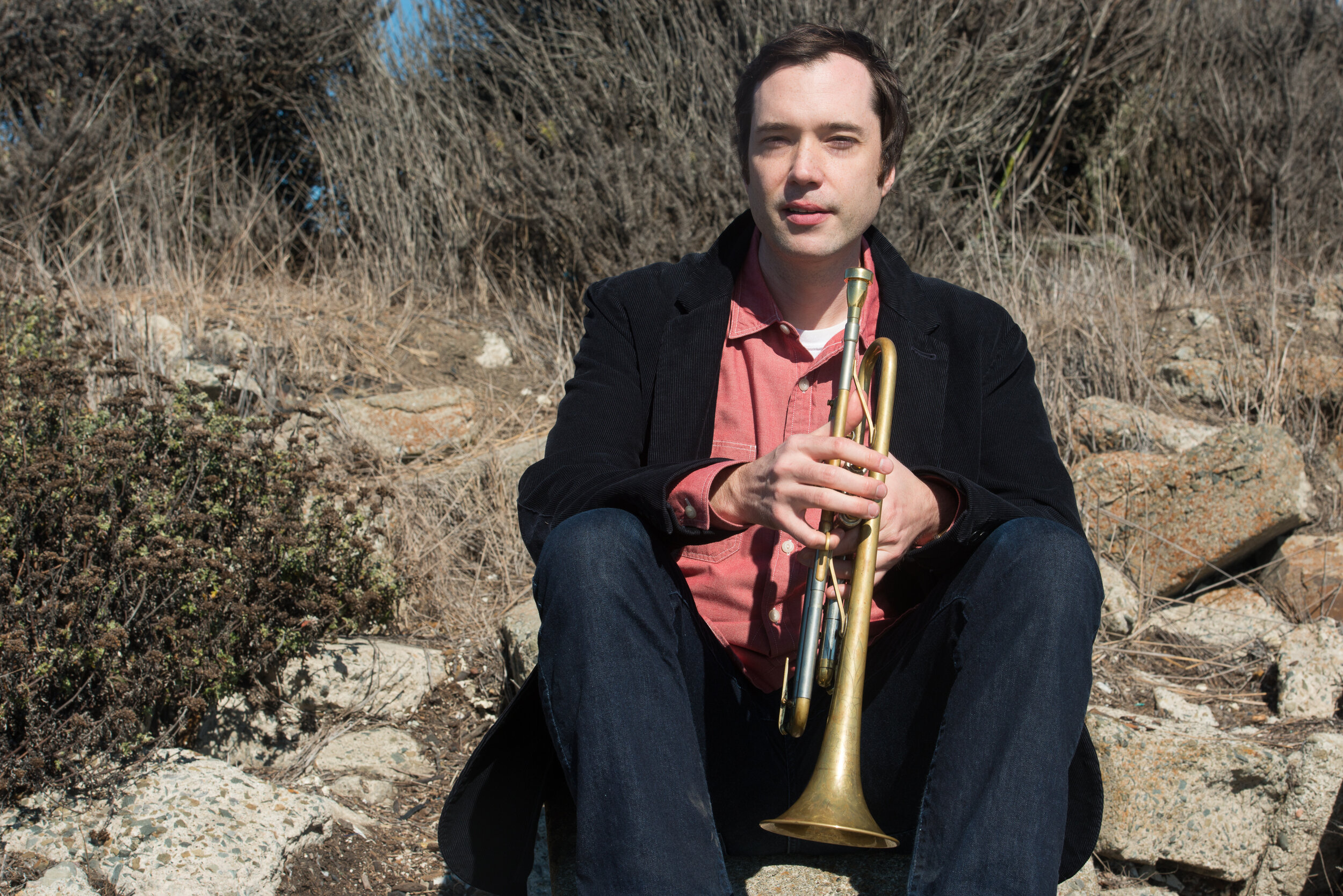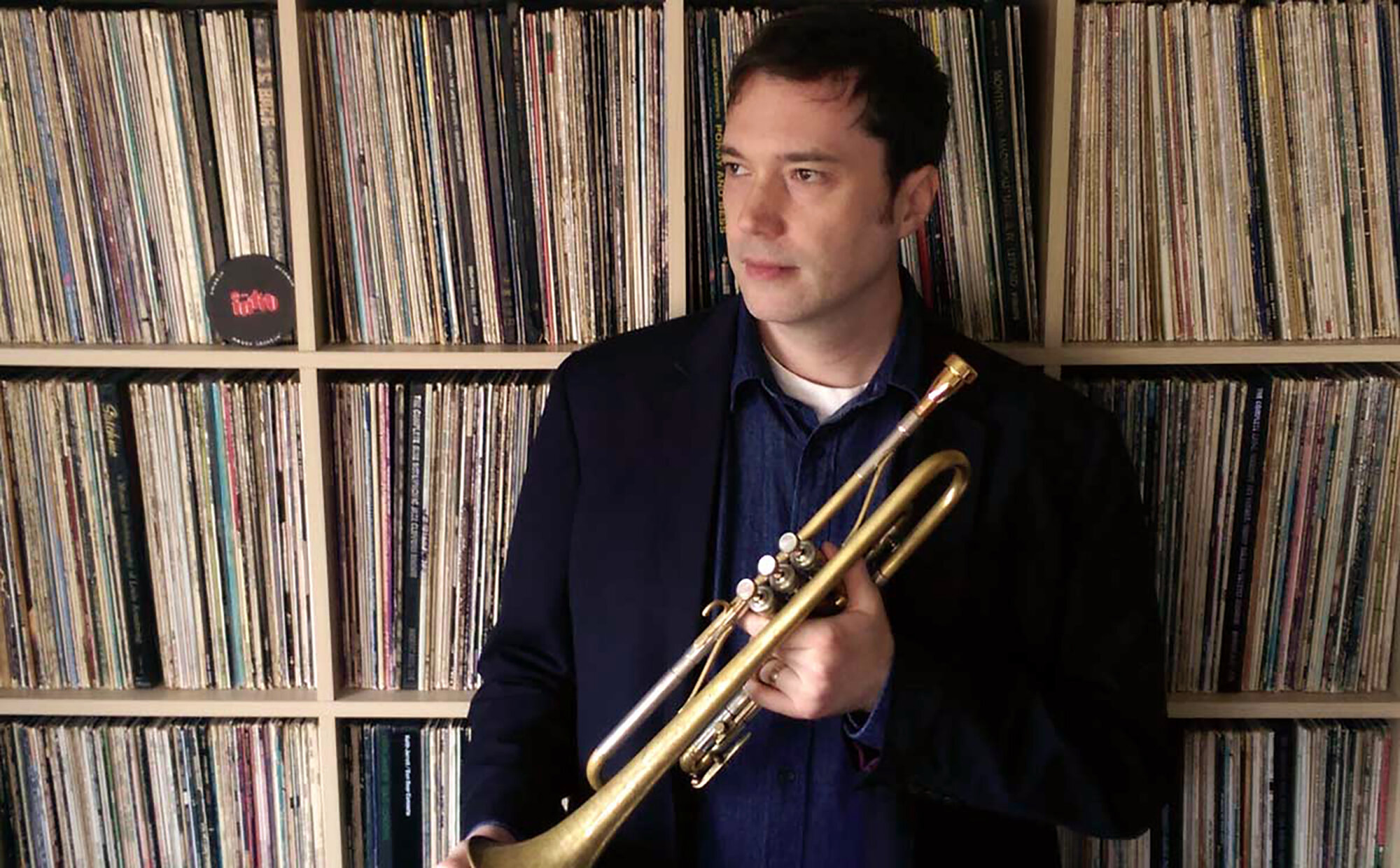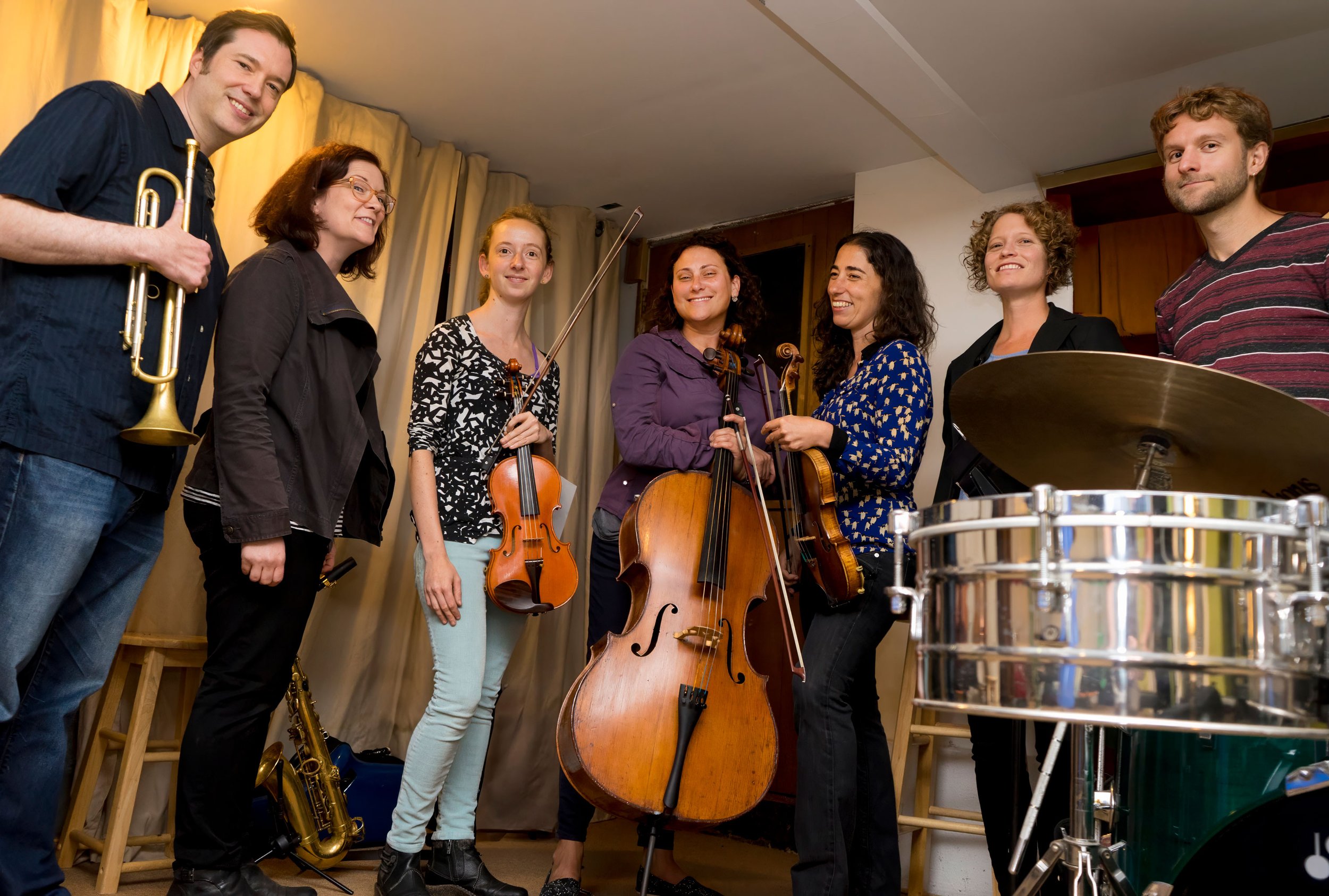About Ian Carey
“You have to say at some point, ‘This is my thing, and I'm gonna do my thing.’“
Ian Carey is a trumpeter, composer, arranger, bandleader and instructor, who “asks deep musical questions and comes up with compelling answers” (Bill Kirchner, editor, The Oxford Companion to Jazz).
Born in 1974 in Binghamton, New York, Carey grew up in a house suffused with music and art. His mother, the late Judi Carey, worked as an illustrator and arts fundraiser. His father Philip was a designer and graphic artist who produced a series of books illustrating his vivid dreams, as well as a vocalist who performed with the Gregg Smith Singers in the 1960s (a chorus that frequently worked with Igor Stravinsky and won a Grammy in 1966 for the Columbia LP Ives: Music for Chorus).
Ian’s first musical outlet was singing in a church choir, where exposure to an Easter brass quintet turned his ear to the trumpet. He started on cornet and French horn in elementary school, but switched to trumpet for good in high school after his family relocated to Folsom, California (site of a now-famous high school jazz program). He studied with Sacramento jazz icon Tom Peron and spent many evenings soaking up the sounds of local musicians including Jessica Williams, Joe Gilman, Steve Homan, and Henry Robinett.
Two years of trumpet studies at the University of Nevada in Reno gave Carey the opportunity to play with visiting artists Eddie Daniels and Ernie Watts and with the Reno Philharmonic. Transferring to The New School in New York City in 1994, he studied trumpet with Cecil Bridgewater, Vincent Penzarella, Charles Tolliver, Laurie Frink, and John McNeil, and composition with Bill Kirchner, Henry Martin, and Maria Schneider. He honed his improvisational chops in small group classes with Joanne Brackeen, Andrew Cyrille, Billy Harper, and Reggie Workman, and had opportunities to perform with a diverse group of players including Ravi Coltrane, Ted Curson, Eddie Bert, Gregoire Maret, Loren Schoenberg, Rory Stuart, Marion Brown, and Eugene Osborne Smith.
After graduating from the New School with a Bachelor’s in Jazz and Contemporary Music, he found himself stuck in a night job as a proofreader, which left him little time to sit in at jam sessions and “make the hang,” let alone pursue gigs. “The music scene in New York was incredibly stimulating, but you end up having to take something totally unrelated to music to pay the rent–even some of the best players had temp jobs–so that got very frustrating,” Carey recalls. After seven years in New York, a friend hooked him up with what was originally a three-month sublet in San Francisco in 2001, and he decided he was ready for a break from the Gotham grind. “I felt right away that this was a good change of scenery,” Carey says. “I met good players quickly and started playing. And I lucked into some graphic design work that was much more creative than what I’d been doing in New York. So the decision to stick around for a while wasn’t too difficult.”
Quickly recognized as a formidable improviser, Carey performed around the Bay Area with top-notch ensembles including: the Electric Squeezebox Orchestra, the Contemporary Jazz Orchestra, Tony Corman’s Morchestra, Anthony Brown’s Asian American Orchestra, Matt Small's Crushing Spiral Ensemble, accordionist Rob Reich’s Circus Bella All-Star Band, the Fred Randolph Quintet, the Nathan Clevenger Group, and the Adam Shulman Sextet; and shared the stage with vocalists Suzanna Smith, Ed Reed, Lorin Benedict, and Betty Fu, pianists Ben Stolorow, Anne Sajdera, and the late Don Alberts, and saxophonists James Mahone and Dayna Stephens, as well as visiting luminaries including pianist/composer Satoko Fujii and Grammy-winning trumpeter/arranger John Daversa. But his ambition was always to create a band focusing on his original material. He got the chance when he landed a regular spot at Financial District watering hole The House of Shields in 2002. The gig lasted for four years, enough time to develop a book of dozens of original tunes. “We got to take a lot of musical chances on that gig,” Carey says. “I don’t think the owners were particularly big fans of the music, but there were three of them, so it took them four years to get around to firing us.”
He first documented the group on 2005’s Sink/Swim, an impressive debut session featuring pianist Adam Shulman, saxophonist and flautist Evan Francis, bassist Fred Randolph, and drummer Jon Arkin. By the time he released 2010’s critically hailed Contextualizin', the band had consciously sidestepped the hard-bop sound by foregrounding Francis’s highly accomplished flute work. In developing the music for Roads & Codes, his third album on his Kabocha Records label, Carey wanted to explore more intricate writing, and move further away from head-solo-head conventions, so he recruited saxophonist Kasey Knudsen to expand the group to a “Quintet+1” format.
“Something I learned from Maria Schneider is to tailor solo sections to strengths of the player,” Carey says. “I don’t just have everyone play over the same changes. Many tunes have two or three different solo sections.”
Featuring original compositions as well as new treatments of works by Charles Ives, Igor Stravinsky, and Neil Young, along with original comic-book-inspired cover art by Carey (who also freelances as a designer and illustrator), Roads & Codes was a critical success, garnering praise from DownBeat (“a highly skilled band of improvisers... ★★★★½”), Doug Ramsey's Rifftides (“keep[s] the listener’s attention not through volume, velocity and extended sorties into the stratosphere, but with storytelling and a burnished tone”), NPR's California Report (“the work of a musician pursuing his own thoughtful, painterly vision”), and author Ted Gioia (“a very underrated player, and a talent to watch”), and turning up on multiple “best of 2013” lists.
Carey's next project was a distinct change of pace: he teamed up with his friend and longtime collaborator pianist Ben Stolorow to release 2014's Duocracy, an intimate collection of standards from the well-known ("How Long Has This Been Going On?" and "All the Things You Are") to the less-frequently heard ("Little White Lies" and Mancini's "Two for the Road"). “It’s super-naked, and that was intimidating at first, especially once the tape started rolling, but it’s also really freeing. On my last album I felt like I was trying to build something perfect,” Carey says, referring to Roads & Codes. “This was about going in and enjoying playing with each other, about playing jazz and seeing what we could come up with, and letting these tunes shine.” Duocracy received praise from DownBeat ("a lively trip down a straightahead path, never veering far from the expected route but obviously deriving a refreshing joy from the familiar sights"), and Jazz Weekly ("Carey’s got a big, fat and wondrous tone and he fills the room while Stolorow mixes stride chords and bop lines to perfection"), and appeared in "Best of 2014" lists from Arnaldo DeSouteiro's "Jazz Station" and W. Royal Stokes.
In 2013 Carey received a grant from Intermusic SF to compose a new four-movement suite, titled "Interview Music," for his Quintet+1 (this time with multi-reed master Sheldon Brown taking the place of Evan Francis, who has since departed for New York), which was premiered in 2014 at the California Jazz Conservatory. The suite was recorded at the legendary Fantasy Studios, and was released as the Quintet+1's fourth album in 2016. Interview Music received praise from Andrew Gilbert of The Mercury News ("Carey finds an exquisite balance between his ambitious compositional vision and his design to showcase his superlative cast of improvisers on his tongue-in-cheek titled five-movement suite"), Doug Ramsey's Rifftides ("[The] sextet plays the five-part suite with drive, wit, swing and a palpable unity of purpose. It is complex chamber music with solo space for Carey, long an impressive trumpeter..."), and Bird is the Word ("Carey’s compositions take his sextet through all kinds of terrain and at all kinds of speeds and in any number of directions. Thankfully, it isn’t weighted down by the changes, but freed, instead, to just sing"), and landed on several "Best of 2016" lists.
In 2016 Carey was featured in two notable books: Ted Gioia’s How to Listen to Jazz (Basic Books), where he was included in a list of “The Elite 150 of Early- and Mid-Career Jazz Masters,” and Thomas Erdmann's How Jazz Trumpeters Play Music Today (Mellen Press) in which he was interviewed along with 11 other noted trumpeters including Christian Scott, Cuong Vu, and Wadada Leo Smith.
In 2017, the Ian Carey Quintet+1 was among fifteen ensembles selected to receive Chamber Music America's prestigious New Jazz Works grant, which commissioned Carey to compose Fire in My Head (The Anxiety Suite), a new 5-part composition which was premiered as part of SFJAZZ's "Exploratory Composers" series at the Joe Henderson Lab in 2018. The suite was released as the group’s fifth album in April 2020.
In 2019, Carey went into the studio with his newest ensemble, Wood Metal Plastic, a 7-piece group that straddles the worlds of chamber music, straightahead jazz, and free improvisation. The resulting album, Strange Arts, explores the aesthetic connections between Carey’s intricate compositions and the vibrant visual artwork of his father, Philip Carey, and will be released on Slow & Steady Records in March 2024.
In addition to his playing and composing, Carey has also been active as a music instructor for many years, teaching private lessons in trumpet, improvisation, harmony, theory, ear training, and composition. He has taught a wide age range of students, from elementary school, to professionals, to adults returning to music. He is on the faculty of Sonoma State University and the Jazzschool, and has been a guest instructor at Stanford University and the Stanford Jazz Workshop, Santa Rosa Junior College, and California Jazz Conservatory.
Carey is also an avid writer and blogger; his post “How Not to Become a Bitter White Jazz Musician” was mentioned by trumpeter Nicholas Payton as “the most brilliant piece that I have ever read about the dynamic of a White person in Black American Music.” His humor writing has also been published at McSweeney's.
“Sometime when I was in my twenties,” Carey says, “I realized that there are so many great, amazing players out there that the context in which I do what I'm doing is going to be how I differentiate myself, and for me that's writing my own tunes and doing my own things within them. I really love learning old jazz tunes and working on all the things you're supposed to know, but I feel like you can do that forever and never catch up to the greats. You have to say at some point, ‘This is my thing, and I'm gonna do my thing.'”

